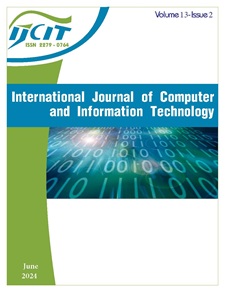The Development of the RSU U2 Net+ Architecture for Brain Tumor Segmentation in 3D Images
DOI:
https://doi.org/10.24203/0ey9jz30Keywords:
Computer Vision, Deep Learning, RSU U^2 Net, Brain TumorAbstract
Segmenting brain tumors in medical images plays a crucial role in diagnosis and monitoring of medical conditions. However, the segmentation process is still performed manually, consuming time and exhibiting variability among assessors. This research aims to develop the RSU U2-Net+ architecture for brain tumor multilabel segmentation in 3D images. The RSU U2-Net+ architecture consists of 9 interconnected blocks, employing broader connectivity in each block. The architecture is reinforced with the use of Residual U-blocks (RSU) to enhance image understanding across various scales without significantly increasing computational load. Testing on data reveals that the RSU U2-Net+ architecture performs well, as indicated by a dice coefficient score of 0.779, IoU of 0.6439, recall of 0.7541, and specificity of 0.9911. Evaluation is also conducted for each tumor label. Recall and specificity for edema are 0.8690 and 0.9851, for enhancing tumor are 0.7991 and 0.9956, and for non-enhancing tumor are 0.5942 and 0.9927. This research makes a significant contribution to the development of advanced medical image analysis technology. The achieved results have tangible benefits for medical practitioners and patients, with the potential to enhance the speed and consistency of brain tumor segmentation in 3D medical images.
References
S. Hadidchi et al., “Headache and Brain Tumor,” Neuroimaging Clin N Am, vol. 29, no. 2, pp. 291–300, 2019, doi: 10.1016/j.nic.2019.01.008.
WHO, Brain, central nervous system. 2020. [Online]. Available: https://gco.iarc.fr/today/data/factsheets/cancers/31-Brain-central-nervous-system-fact-sheet.pdf
K. Dananjoyo, W. Nalendra Tama, R. Ghazali Malueka, A. Asmedi Staf Departemen Neurologi Fakultas Kedokteran, K. Masyarakat dan Keperawatan, and U. Gadjah Mada, “Nyeri kepala tumor otak pada dewasa Brain tumor headache in adult,” 2019.
M. Nadia Putri, I. Katili, A. Hariri, T. Asih Budiati, and G. Murti Wibowo, “94-2,5) Poltekkes Kemenkes Semarang, Indonesia 3,4) Pertamina Central Hospital Jakarta,” JImeD), vol. 7, 2021, [Online]. Available: http://ejournal.poltekkes-smg.ac.id/ojs/index.php/jimed/index
M. S. Swetha and M. P. Devi, “NEURAL NETWORK SEGMENTATION IN MRIs IMAGES FOR BRAIN TUMORs SEGMENTATIONs,” International Journal of Scientific Research in Engineering and Management, 2022, doi: 10.55041/IJSREM12703.
M. B. Sudhan et al., “Segmentation and Classification of Glaucoma Using U-Net with Deep Learning Model,” J Healthc Eng, vol. 2022, 2022, doi: 10.1155/2022/1601354.
I. B. L. M. Suta, M. Sudarma, and I. N. Satya Kumara, “Segmentasi Tumor Otak Berdasarkan Citra Magnetic Resonance Imaging Dengan Menggunakan Metode U-NET,” Majalah Ilmiah Teknologi Elektro, vol. 19, no. 2, p. 151, Dec. 2020, doi: 10.24843/mite.2020.v19i02.p05.
O. Ronneberger, P. Fischer, and T. Brox, “U-Net: Convolutional Networks for Biomedical Image Segmentation,” May 2015, [Online]. Available: http://arxiv.org/abs/1505.04597
M. Kolařík, R. Burget, V. Uher, K. Říha, and M. K. Dutta, “Optimized high resolution 3D dense-U-Net network for brain and spine segmentation,” Applied Sciences (Switzerland), vol. 9, no. 3, Jan. 2019, doi: 10.3390/app9030404.
Y. He, D. Yang, H. Roth, C. Zhao, and D. Xu, “DiNTS: Differentiable Neural Network Topology Search for 3D Medical Image Segmentation,” Mar. 2021, [Online]. Available: http://arxiv.org/abs/2103.15954
X. Qin, Z. Zhang, C. Huang, M. Dehghan, O. R. Zaiane, and M. Jagersand, “U$^2$-Net: Going Deeper with Nested U-Structure for Salient Object Detection,” May 2020, doi: 10.1016/j.patcog.2020.107404.
M. Ghaffari, A. Sowmya, and R. Oliver, “Automated Brain Tumor Segmentation Using Multimodal Brain Scans: A Survey Based on Models Submitted to the BraTS 2012-2018 Challenges,” IEEE Rev Biomed Eng, vol. 13, pp. 156–168, 2020, doi: 10.1109/RBME.2019.2946868.
Z. Tabatabaei, A. Colomer, K. Engan, J. Oliver, and V. Naranjo, “Residual block Convolutional Auto Encoder in Content-Based Medical Image Retrieval,” in IVMSP 2022 - 2022 IEEE 14th Image, Video, and Multidimensional Signal Processing Workshop, Institute of Electrical and Electronics Engineers Inc., 2022. doi: 10.1109/IVMSP54334.2022.9816325.
Z. Zhou, M. M. R. Siddiquee, N. Tajbakhsh, and J. Liang, “UNet++: A Nested U-Net Architecture for Medical Image Segmentation,” Jul. 2018, [Online]. Available: http://arxiv.org/abs/1807.10165
X. Liu, L. Song, S. Liu, and Y. Zhang, “A review of deep-learning-based medical image segmentation methods,” Sustainability (Switzerland), vol. 13, no. 3, pp. 1–29, Feb. 2021, doi: 10.3390/su13031224.
M. K. Abd-Ellah, A. I. Awad, A. A. M. Khalaf, and H. F. A. Hamed, “A review on brain tumor diagnosis from MRI images: Practical implications, key achievements, and lessons learned,” Magnetic Resonance Imaging, vol. 61. Elsevier Inc., pp. 300–318, Sep. 01, 2019. doi: 10.1016/j.mri.2019.05.028.
Z. Zhou, M. M. Rahman Siddiquee, N. Tajbakhsh, and J. Liang, “Unet++: A nested u-net architecture for medical image segmentation,” in Lecture Notes in Computer Science (including subseries Lecture Notes in Artificial Intelligence and Lecture Notes in Bioinformatics), Springer Verlag, 2018, pp. 3–11. doi: 10.1007/978-3-030-00889-5_1.
Downloads
Published
Issue
Section
License
Copyright (c) 2024 ELvaret Elvaret, Habibullah Akbar

This work is licensed under a Creative Commons Attribution-NonCommercial 4.0 International License.
The articles published in International Journal of Computer and Information Technology (IJCIT) is licensed under a Creative Commons Attribution-NonCommercial 4.0 International License.


